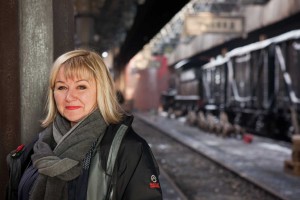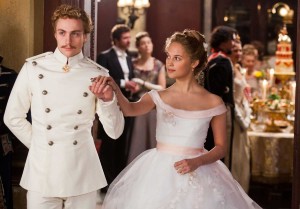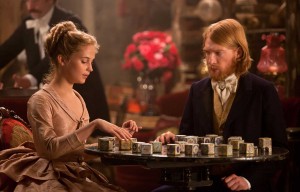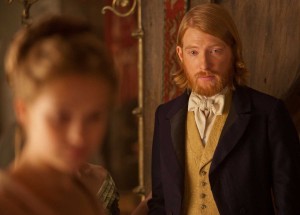
Production designer Sarah Greenwood, a three-time Oscar nominee, had to turn on a dime when director Joe Wright suddenly decided to drop plans to make Anna Karenina on location in Russia. Instead he opted to film author Leo Tolstoy’s classic novel, about the tragic consequences of an adulterous late-19th century love affair, as if it unfolded within the confines of a crumbling old theatre, a metaphor for the decaying aristocracy of the era.
With only a few months left before the shoot was set to start, Greenwood had to start thinking of ways to theatricalize the design for Anna Karenina to accommodate the new concept. Over that time she managed to create 100 detailed, often lavish settings, including a large ballroom filled with dancers, the interior of an opera house, an outdoor ice skating rink, rooms in country houses and a horse race on an indoor course.
Anna Karenina wound up being an epic production filmed over 12 weeks on 100 different sets, across 240 scenes, with 83 speaking parts. The stars are Keira Knightly as Anna, Aaron-Taylor Johnson as her lover, the dashing cavalier Vronsky and Jude Law as her cuckolded husband Karenin.

Fortunately, Greenwood and other members of the crew had already traveled to St. Petersburg and Moscow with Wright to check out possible locations when the idea was to shoot the film there. “I had become very well informed on the look of Russia in that period which turned out to be very useful,” she noted. Greenwood said she was inspired by Russian paintings in museums she had visited there and also pictures in voluminous art books. “Everything we did within the design was, from our point of view, absolutely period and Russian,” she observed. And she had high praise for her longtime set decorator Katie Spencer for her work.
After checking out some possible spots in London, like the condemned Alexandra Palace theatre, it was decided to construct sets from scratch. “We had to build the theatre on a stage because it needed to be a built environment for us to be able to control it,” she explained. “We had a lot of fantastic imagery to deploy.”
The interior of the imaginary theatre set was built on the huge C Stage at Shepperton Studios – the same stage where the wartime hospital scenes were filmed in Atonement. That film and Pride & Prejudice were also collaborations between Wright and the production designer, and her work on both films earned Greenwood Oscar nominations for best art direction. She also was nominated for an Academy Award for Sherlock Holmes in 2009.
 The production designer relied on many old art direction techniques, including the use of painted backdrops. “We did over 50, from conventional backdrops, to art on the wall,” she said, employing three veteran scenic artists. “It was fantastic to go back and use this methodology,” said Greenwood.
The production designer relied on many old art direction techniques, including the use of painted backdrops. “We did over 50, from conventional backdrops, to art on the wall,” she said, employing three veteran scenic artists. “It was fantastic to go back and use this methodology,” said Greenwood.
“In a funny kind of way, as much as it was lush and rich and intense, it was also minimalist, in that we quite often wanted to convey something simply,” she observed. For example, the skating scene at the outdoors ice rink surrounded by snow with St. Petersburg’s Neva River frozen over in the background, was a relatively simple set. “It needed nothing else,” Greenwood said.
Other sets were more elaborate, such as when Vronsky comes to see Anna as she departs on the train. “A real train from the period was found, the carriage was made to look as accurate as it could be, and the ice frozen all over it we created by adding many layers of wax,” she explained. “The indoor horse race was technically tricky. You couldn’t have live horses and riders racing across the theatre stage,” she said. The interior scene with the spectators was filmed against green screen and the horses racing at night were filmed separately. “I think people who see it absolutely believe the horses are indoors,” she said.
 “Some of the big set pieces were among the easiest ones to do,” she commented, pointing to the elaborately choreographed ballroom sequence. “We basically put in a painted marble floor, and there was painted artist scenery, although quite tricky to execute, at the back.”
“Some of the big set pieces were among the easiest ones to do,” she commented, pointing to the elaborately choreographed ballroom sequence. “We basically put in a painted marble floor, and there was painted artist scenery, although quite tricky to execute, at the back.”
The only important scenes filmed on location were when the idealistic Levin character is scything in the vast Russian wheat fields with his peasant workers. These were filmed on Salisbury Plain – the closest approximation to massive open Russian plains in the United Kingdom. “It hasn’t really been touched in 200 years and stays that way because of the army base there,” said Greenwood.
One reason for pursuing the theater-stage design approach was budgetary. “We had been struggling to make this massive epic Russian novel in the conventional way, and by doing it like this it made our money go further because we could be more clever in our ideas,” said Greenwood. “You always end up thinking harder and thinking better when you have financial constraints.”





